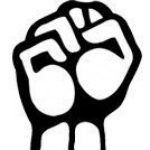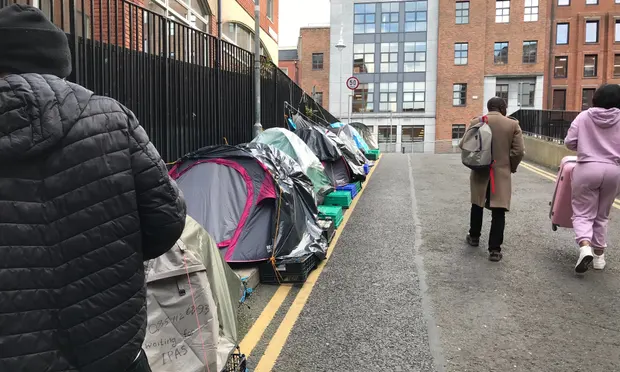The violent events in Dublin’s city centre on Friday 12 May 2023 when groups of Dublin based people set upon five hundred plus asylum seekers, forced to live in tents outside the International Protection Office in Sandwith Street, setting their belongings on fire and shouting racist abuse at them were very troubling indeed. Lawyer and activist Gary Daly, who came to stand in solidarity with the asylum seekers, wrote on his Facebook page that what was particularly disturbing was that “the people threatening extreme violence or calling all refugees ‘rapists’ sounded just like me. They were Dublin voices… I recognised the accents, but I was a stranger to the language used. Claiming that we (those standing between them and the homeless migrant camp on Sandwith Street) were all ‘anteefa’ or ‘government shills’ or ‘paid NGOs’. This language is imported only very recently from far-right America.”
Following the Ukraine refugee crisis, the number of people seeking international protection in Europe has grown exponentially. Ireland is currently housing 19,874 asylum seekers, including 4,139 children, in 172 locations around the country. This is a 90 per cent increase in a year and a 266 per cent increase since 2018. Although still high when compared with pre-2022 figures, the number of applications has gone down considerably in recent weeks according to data provided by the Department of Justice.
The much-criticised Direct Provision system, inadequate as it was, and epitomising Ireland’s ‘asylum industrial complex’ whereby private landlords and hotel owners had been paid millions of euros to house thousands of asylum seekers by the government, that is, by Irish tax-payers, as Vukašin Nedeljković and I reported in Disavowing Asylum: Documenting Ireland’s Asylum Industrial Complex, is no longer able to cope. Hotel owners have reverted to the more profitable tourism business which the government prefers to nurture at the expense of accommodating applicants for international protection, and hotels are no longer available. Due to Ireland’s disastrous housing and homelessness crisis, the result is a huge shortage of accommodation to newly arriving asylum seekers, 580 of whom are currently camping on the streets of Dublin, some in tents outside the ironically named International Protection Office, where they have been subjected to appalling racism by what has been described by some activists as ‘fearful local working class communities’ rather than by white Irish racists.
Gary Daly, who has been in the front of many anti-racist protests and counter demonstrations against the rise of the burgeoning Irish far right, notes that although the pro refugee demonstrators included some “grifting, weasel, selfie-stick provocateurs”, in the main he was surrounded by members of community support groups, homeless charities, Traveller action groups, socialist and activist groups committed to fighting inequality for many years. They were mostly facing people from Dublin’s inner-city centre who were promised that the area was due for regeneration and worried about it now that migrants were camping on the streets. According to Daly, “the Dublin I grew up in pre-Celtic tiger had many problems, but I don’t remember such slavish importation of foreign hate speech. The type of language that was used against Irish immigrants in Britain and America for decades.” And, attesting to the violent nature of the anti-refugee sentiment, activist Clare Holohan wrote on her Facebook page about what she witnessed on Sandwith street:
“I walked past the IPO with the intention of offering my solidarity and support to the asylum seekers in tents. I arrived at the scene to find a woman holding an Irish flag shouting obscenities and vile language to another Irish lady who was defending the refugees. The road was blocked off and the Gardai were observing the situation whilst simultaneously allowing this racist abuse go unabated… Two men and women were shouting ‘house our own first!’ ‘They are only here for money;’ ‘There is no war.’ The women then approached two African asylum seekers and shouted ‘GO BACK HOME, YOU ARE ONLY HERE FOR THE MONEY!! The man said explicitly three times ‘You BLACK F*** N****R GO HOME.’ His voice full of rage and hate. At this point I couldn’t control my anger and shouted at him that he was a racist and I wanted to report him for hate speech. I was told ‘GO HOME YOU BROWN B****.’ I told him, ‘I am Irish, I am home.’ He laughed and said, ‘You Wish.’ I instantly went to one of the Gardai and told him what had happened, and he just told me to ‘move on’.”
When I expressed solidarity with the refugees and their supporters, particularly for the Movement of Asylum Seekers in Ireland (MASI) on my Facebook page, I was told off not merely by racists speaking of ‘stinking refugees’ taking the place of ‘our own people’ (see for instance the abusive Facebook page StandUp Mahon), but also by liberal journalists and activists advising me to ‘listen to the fears’ of ‘local working class communities’ and particularly women, persuaded by far right agitators that refugees endanger their safety and integrity, believing, as do so many other white people, that all refugees and Black people are rapists and that ‘too much mixing’ endangers the integrity of white families. This needs some analysis, as it is not the first time that immigration becomes, in the words of French sociologist Etienne Balibar, the name of race, and that the inadequacies of the state system, in housing, education, health and other services, are blamed on migrants and refugees.
In Fractured: Race, Class, Gender and the Hatred of Identity Politics, Michael Richmond and Alex Charnley document what they call ‘whiteness riots.’ These are sparks of violence, supposedly carried out spontaneously by white working-class mobs against Black people and migrants. These are usually followed up by ‘race reports’ and legislative reactions, designed to impose control through the market, but also the courts, social care, schools, border forces and policing. These supposedly legal instruments work to racialise states and societies, formalising, institutionalising and modernising racial rule. The ‘whiteness riots’ Richmond and Charnley document both in the UK and the US (though of course they happened and still happen elsewhere) are in fact psychodramas of white nationhood. Thus Enoch Powell’s could instigate the post-World War II war on immigration into Britain, but thus too did neutral Ireland refuse to admit more than sixty Jewish refugee from Nazi controlled Europe between 1933 and 1946 – which was the first instance of the Republic of Ireland’s racist immigration controls that prevented the admission of refugees by the state, but that was also accompanied by popular Irish opposition to Jewish migrants, then seen by none other than Arthur Griffith as ‘forever and always alien’, and now to racialised migrants and refugees.
Importantly, white anti-migrant mob riots are not separate from state action and often stem from the same impetus to racialise the white nation that sees the working class as exclusively white – which is clearly not the case. In Britain and the US substantial repatriations of racialised workers were seen as a success for the white rioters, but we should remember that the rioters’ motive is not class struggle, but rather direct action taken by the ‘white community’ as a way of inflicting direct violence based on racial hatred. White rioters and governments ultimately play the same tune, as far right agitators and rioters demand that governments institute stricter immigration controls, and often a stringent racial division of labour, even though the capitalist labour market depends on migrant workers.
The exclusion of Jewish refugees from Ireland during the Nazi era eventually resulted in an ever-decreasing Jewish community, many of whose young members have left Ireland. However, Ireland’s restrictive asylum and immigration policies over the years, as well as the Direct Provision system, have not managed to stem the flow of people both seeking work and applying for international protection. The ongoing protests against accommodation centres for asylum seekers throughout the country and particularly the violent attacks against asylum seekers’ enforced encampments in Dublin city centre are whiteness riots par excellence. Not only do they presume a white Irish working class ‘us’ – complete with all the injustices of homelessness and housing crisis – and a non-white migrant ‘them’ – complete with all the injustices of Ireland’s unwillingness to fulfil its commitments to international law, but they are primarily motivated by racism. As Richmond and Charnley write, explaining ‘whiteness riots’ only in terms of capital-labour relations, or ‘justified fears’ is inadequate:
‘Whiteness riots displayed the peculiar and murderous racial animus of white supremacy. In each country, a similar construction of Blackness as both ontological threat and social control conundrum precede the violence. Each regime benefitted from racialised reserve armies of labour… Due agency must be given to the racism (and occasional anti-racism) of white workers… State violence and popular racism have been the sorting techniques of history, helping to shape the representational schema of the nation: who is deserving and undeserving of its protection? Who can do which jobs? Who can live where? Who can marry or touch its daughters?’
From ‘Taking back control,’ Brexit, and ‘Make America Great again’ to Sandwith Street – racism continues to be indexed to national borders and racial divisions of labour, and the only anti-racist response is the total rejection of border imperialism.

